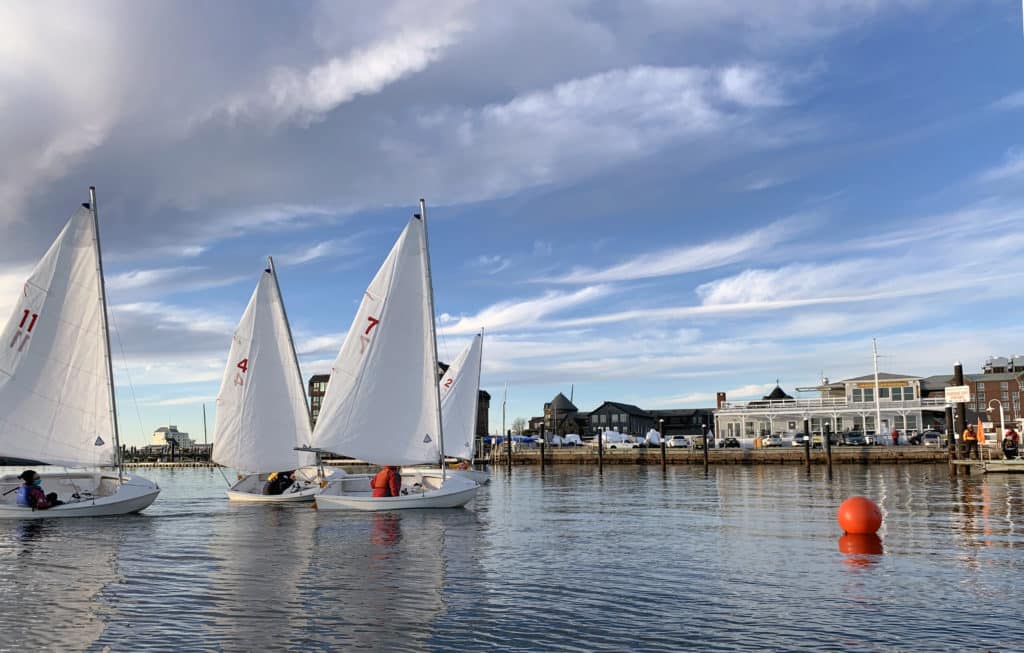
We go upwind. We go downwind…the sort of sausage-style racing we’ve all grown accustomed to. Yes, reach legs are a rarity in most one-design fleets, but not with Newport YC’s Turnabout Frostbite series, where every race finish is recorded from the launch dock out in front of the club. Here, there’s a handheld blue flag that marks the spot and a bench seat for a volunteer recorder to hail their sail number as racers cruise past. With the typical winter northerly at the top of Newport Harbor, the final leg is always a reach. It’s usually a couple hundred feet from the weather mark—rounded to starboard so as to project us mitten-clad racers straight to the finish line and on to the rotation dock.
Now, mind you this last leg should be parade, but often, it’s not.
Let me Boss Ross the scene for you: When the wind is out of the north-northwest, the race committee plops the orange weather mark buoy right up snug against the big rust-bucket trawlers of the local fishing fleet parked at the State Pier. Immediately to the east of the piles of big blue chum buckets and lobster traps is a four-or-so-story slab-sided condominium building, and next to that, a few lower brick-and-mortar waterfront shacks. Then, there’s the two-story yacht club itself, and the docks and slips full of stinkpots and sailboat wrapped in their winter plastic. Now, imagine a weak and cold winter wind streaking through, above, below and around all these obstacles and eyesores.
That’s the kind of wind that’ll blow across our notorious reach-leg to glory. Oftentimes there’s just enough west in the breeze to make this an easy-peasy-stay-between-the-finish-and-the-guy-behind-you situation. Pull that breeze to the north and through the shoreline chaos, you’ve got yourself a stress-fest.
I know firsthand. I’ve been the beneficiary of a magic puff a few times so far this season, but I’ve also been the victim more than once. This past weekend, it happens to me again—big time.
There I am, turning upwind, second around the leeward mark, two lengths behind Amanda Callahan, who has pretty much schooled the A fleet all season long. I’m feeling pretty good about myself right then and there: good start, good first beat, smooth run. I immediately start thinking about how to get past her.
She tacks soon after rounding, and I have a decision to make. Go with her, or go deeper into the right side and try to get around her. But it looks light out to the right, so I follow her lead back to the middle. The middle, however, is riddled with alternating streaks of wind and glass. I get whiff of chum from the fishing boats and the streaks are giving me severe anxiety as they seemed impossible to discern what’s really a shift or not and whether it’s reliable enough to risk a few more speed-sapping tacks.
While the two of us are agonizingly chipping our way through the streaks, a group of four boats way out on the starboard layline come cruising in on a glorious and happy line of breeze.
“Ah, crap,” I mutter. “That’s four.”
Soon, I round the weather buoy behind this group. There’s no way I’m getting past them on this reach. I’ve got a few comfortable lengths on the next pack behind me, so I focus on the boats ahead and notice with glee the big glassy hole they’re sailing into in the lee of the clubhouse. Should I go high or low to set up a last-minute pass? I try high, but that feels slow and there’s no wind up there anyway. I try low, and I’m slowly making gains until the breeze suddenly swings forward. My mainsail luffs and the plastic sail slugs jingle in the aluminum mast track. Now we’re all going upwind. A few of the boats ahead are no longer fetching the finish mark and tacking back to starboard.
All my attention is drawn to their struggle, and then the struggle becomes mine.
The boat comes to a complete stop. In a moment of panic, I clumsily throw my weight to leeward to heel the boat and will it forward. With my new point of view, however, I behold the gutting sight of those trailing boats steaming down from on high with a generous gust of their own. I’m am stuck, as if glued to the water as they ghost past me to weather and cruise to the finish line with only their momentum.
I’m laughing. But I’m not really laughing until I see my rival FJ Ritt below me, on his knees and desperately trying to get back to the finishing line on starboard tack. Only minutes ago, he’d been way ahead of me. Miraculously, I just sneak past his bow and nip him at the finish.
Misery, they say, loves company, and both of us had indeed been ignominiously flushed to the back of the fleet.
In the moment, I chalk it up to dumb luck, but I will admit that I carry this reach-leg nightmare to my pillow this very night, the scene repeating in slow motion in my head. I realize I’d been so focused on what was happening ahead of me that I’d neglected to pay attention to what was happening behind. I’m sure there’s some equivalent life-coach-type lesson here, but it is sailboat racing after all and best not to overthi









